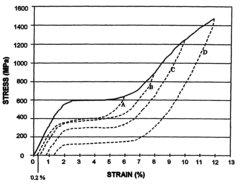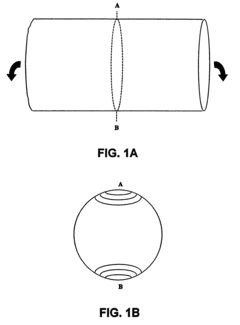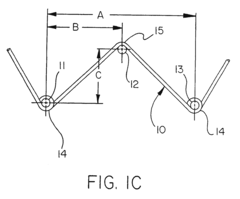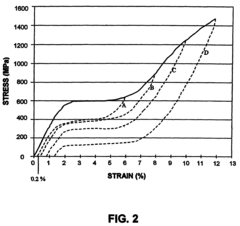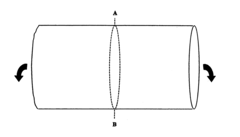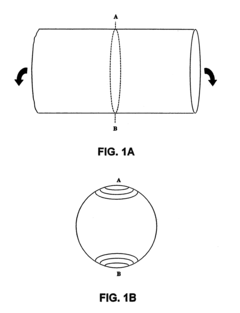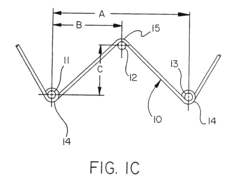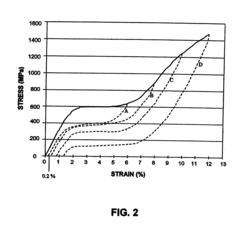Hastelloy Strategies to Combat Material Fatigue
JUL 10, 20259 MIN READ
Generate Your Research Report Instantly with AI Agent
Patsnap Eureka helps you evaluate technical feasibility & market potential.
Hastelloy Fatigue Background and Objectives
Hastelloy, a family of nickel-chromium-based superalloys, has been at the forefront of material science for decades, particularly in applications requiring exceptional corrosion resistance and high-temperature strength. The evolution of Hastelloy has been driven by the increasing demands of industries such as aerospace, chemical processing, and nuclear power generation, where material performance under extreme conditions is critical.
The development of Hastelloy can be traced back to the 1920s when researchers at Haynes Stellite Company sought to create alloys capable of withstanding severe corrosive environments. Over the years, various grades of Hastelloy have been developed, each tailored to specific operational requirements. The continuous refinement of these alloys has led to significant improvements in their mechanical properties, corrosion resistance, and fatigue performance.
Material fatigue in Hastelloy components has emerged as a crucial concern, particularly in applications involving cyclic loading and thermal stresses. As industrial processes become more demanding, the need for materials that can maintain their integrity over extended periods under harsh conditions has intensified. This has propelled research into understanding and mitigating fatigue mechanisms in Hastelloy alloys.
The primary objective of current research and development efforts is to enhance the fatigue resistance of Hastelloy without compromising its other desirable properties. This involves a multifaceted approach, including microstructural optimization, surface treatment techniques, and the exploration of novel alloying elements. Researchers aim to develop strategies that can extend the fatigue life of Hastelloy components, thereby improving the reliability and longevity of critical industrial equipment.
Another key goal is to establish more accurate predictive models for fatigue behavior in Hastelloy alloys. This includes the development of advanced testing methodologies and the integration of data-driven approaches to better understand and forecast material performance under various operational conditions. Such models are essential for optimizing component design and maintenance schedules in high-stakes applications.
Furthermore, there is a growing emphasis on understanding the interplay between corrosion and fatigue in Hastelloy alloys. This synergistic effect can significantly accelerate material degradation in certain environments, necessitating the development of comprehensive strategies that address both phenomena simultaneously. The ultimate aim is to create Hastelloy variants or treatment processes that exhibit superior resistance to both corrosion and fatigue, thereby expanding the range of applications and operational lifespans of components made from these alloys.
The development of Hastelloy can be traced back to the 1920s when researchers at Haynes Stellite Company sought to create alloys capable of withstanding severe corrosive environments. Over the years, various grades of Hastelloy have been developed, each tailored to specific operational requirements. The continuous refinement of these alloys has led to significant improvements in their mechanical properties, corrosion resistance, and fatigue performance.
Material fatigue in Hastelloy components has emerged as a crucial concern, particularly in applications involving cyclic loading and thermal stresses. As industrial processes become more demanding, the need for materials that can maintain their integrity over extended periods under harsh conditions has intensified. This has propelled research into understanding and mitigating fatigue mechanisms in Hastelloy alloys.
The primary objective of current research and development efforts is to enhance the fatigue resistance of Hastelloy without compromising its other desirable properties. This involves a multifaceted approach, including microstructural optimization, surface treatment techniques, and the exploration of novel alloying elements. Researchers aim to develop strategies that can extend the fatigue life of Hastelloy components, thereby improving the reliability and longevity of critical industrial equipment.
Another key goal is to establish more accurate predictive models for fatigue behavior in Hastelloy alloys. This includes the development of advanced testing methodologies and the integration of data-driven approaches to better understand and forecast material performance under various operational conditions. Such models are essential for optimizing component design and maintenance schedules in high-stakes applications.
Furthermore, there is a growing emphasis on understanding the interplay between corrosion and fatigue in Hastelloy alloys. This synergistic effect can significantly accelerate material degradation in certain environments, necessitating the development of comprehensive strategies that address both phenomena simultaneously. The ultimate aim is to create Hastelloy variants or treatment processes that exhibit superior resistance to both corrosion and fatigue, thereby expanding the range of applications and operational lifespans of components made from these alloys.
Market Demand Analysis for Fatigue-Resistant Hastelloy
The market demand for fatigue-resistant Hastelloy has been steadily increasing across various industries due to its exceptional performance in harsh environments. Hastelloy, a nickel-chromium-molybdenum alloy, is renowned for its superior corrosion resistance and mechanical properties, making it ideal for applications where material fatigue is a critical concern.
In the oil and gas sector, the demand for fatigue-resistant Hastelloy has surged as exploration and production activities move into more challenging environments. Offshore platforms, subsea equipment, and downhole tools require materials that can withstand extreme pressures, temperatures, and corrosive conditions while maintaining structural integrity over extended periods. The ability of fatigue-resistant Hastelloy to combat material degradation in these demanding scenarios has led to its increased adoption in critical components.
The chemical processing industry has also shown a growing interest in fatigue-resistant Hastelloy. As chemical manufacturers seek to improve process efficiency and reduce downtime, the use of materials that can resist fatigue under cyclic loading and corrosive environments has become paramount. Reactors, heat exchangers, and piping systems in chemical plants benefit from the enhanced durability offered by fatigue-resistant Hastelloy, leading to longer equipment lifespans and reduced maintenance costs.
In the aerospace sector, the demand for lightweight yet durable materials has driven the adoption of fatigue-resistant Hastelloy in aircraft engine components and structural elements. The ability to withstand high temperatures and resist fatigue under constant vibration and stress makes it an attractive option for manufacturers looking to improve fuel efficiency and safety in aviation.
The power generation industry, particularly in nuclear and renewable energy sectors, has also contributed to the growing market for fatigue-resistant Hastelloy. Nuclear reactors and steam turbines require materials that can maintain their integrity under extreme conditions for extended periods. Similarly, wind turbines and solar thermal systems benefit from the use of fatigue-resistant alloys in critical components exposed to cyclic loading and environmental stresses.
Market analysts project a compound annual growth rate for the fatigue-resistant Hastelloy market in the coming years, driven by increasing industrialization and the need for advanced materials in emerging economies. The expansion of manufacturing capabilities and the development of new applications in sectors such as electronics and medical devices are expected to further boost demand.
However, the market faces challenges such as the high cost of raw materials and complex manufacturing processes, which may limit adoption in cost-sensitive applications. Additionally, competition from alternative materials and alloys presents ongoing challenges to market growth. Despite these factors, the unique combination of properties offered by fatigue-resistant Hastelloy continues to drive its demand across diverse industrial sectors.
In the oil and gas sector, the demand for fatigue-resistant Hastelloy has surged as exploration and production activities move into more challenging environments. Offshore platforms, subsea equipment, and downhole tools require materials that can withstand extreme pressures, temperatures, and corrosive conditions while maintaining structural integrity over extended periods. The ability of fatigue-resistant Hastelloy to combat material degradation in these demanding scenarios has led to its increased adoption in critical components.
The chemical processing industry has also shown a growing interest in fatigue-resistant Hastelloy. As chemical manufacturers seek to improve process efficiency and reduce downtime, the use of materials that can resist fatigue under cyclic loading and corrosive environments has become paramount. Reactors, heat exchangers, and piping systems in chemical plants benefit from the enhanced durability offered by fatigue-resistant Hastelloy, leading to longer equipment lifespans and reduced maintenance costs.
In the aerospace sector, the demand for lightweight yet durable materials has driven the adoption of fatigue-resistant Hastelloy in aircraft engine components and structural elements. The ability to withstand high temperatures and resist fatigue under constant vibration and stress makes it an attractive option for manufacturers looking to improve fuel efficiency and safety in aviation.
The power generation industry, particularly in nuclear and renewable energy sectors, has also contributed to the growing market for fatigue-resistant Hastelloy. Nuclear reactors and steam turbines require materials that can maintain their integrity under extreme conditions for extended periods. Similarly, wind turbines and solar thermal systems benefit from the use of fatigue-resistant alloys in critical components exposed to cyclic loading and environmental stresses.
Market analysts project a compound annual growth rate for the fatigue-resistant Hastelloy market in the coming years, driven by increasing industrialization and the need for advanced materials in emerging economies. The expansion of manufacturing capabilities and the development of new applications in sectors such as electronics and medical devices are expected to further boost demand.
However, the market faces challenges such as the high cost of raw materials and complex manufacturing processes, which may limit adoption in cost-sensitive applications. Additionally, competition from alternative materials and alloys presents ongoing challenges to market growth. Despite these factors, the unique combination of properties offered by fatigue-resistant Hastelloy continues to drive its demand across diverse industrial sectors.
Current Challenges in Hastelloy Fatigue Resistance
Hastelloy, renowned for its exceptional corrosion resistance and high-temperature strength, faces significant challenges in maintaining its fatigue resistance under extreme conditions. The primary issue stems from the material's susceptibility to cyclic loading, particularly in environments that combine high temperatures and corrosive elements. This vulnerability can lead to premature failure in critical applications, such as aerospace components, chemical processing equipment, and nuclear reactors.
One of the key challenges is the formation and propagation of microcracks under cyclic stress. These microcracks often initiate at grain boundaries or at sites of localized corrosion, and their growth can be accelerated by the synergistic effects of mechanical stress and environmental factors. The complex microstructure of Hastelloy, while beneficial for its overall properties, can sometimes contribute to the initiation of these fatigue-induced defects.
Another significant challenge is the degradation of Hastelloy's mechanical properties at elevated temperatures. As temperatures increase, the material's yield strength and ultimate tensile strength decrease, making it more susceptible to plastic deformation and fatigue damage. This temperature-dependent behavior complicates the design process for components that must operate reliably in high-temperature environments over extended periods.
The presence of aggressive chemical environments further exacerbates the fatigue resistance challenges. Corrosive media can accelerate crack initiation and propagation by weakening grain boundaries and promoting localized attack. This is particularly problematic in applications where Hastelloy is exposed to both cyclic loading and corrosive substances, as the combined effect can lead to a significant reduction in fatigue life.
Moreover, the interaction between creep and fatigue mechanisms presents a complex challenge. At high temperatures, creep deformation can occur simultaneously with fatigue cycling, leading to creep-fatigue interaction. This phenomenon can result in accelerated damage accumulation and reduced component life, making it difficult to predict long-term performance accurately.
The variability in fatigue behavior across different Hastelloy alloys adds another layer of complexity. While some variants exhibit superior fatigue resistance in certain environments, they may underperform in others. This necessitates careful alloy selection and tailoring for specific applications, which can be a challenging and time-consuming process.
Lastly, the development of reliable predictive models for Hastelloy fatigue life remains a significant challenge. The complex interplay of factors such as temperature, stress state, environmental conditions, and microstructural evolution makes it difficult to create accurate, widely applicable models. This limitation hampers the ability to optimize component design and establish confident service life predictions for critical applications.
One of the key challenges is the formation and propagation of microcracks under cyclic stress. These microcracks often initiate at grain boundaries or at sites of localized corrosion, and their growth can be accelerated by the synergistic effects of mechanical stress and environmental factors. The complex microstructure of Hastelloy, while beneficial for its overall properties, can sometimes contribute to the initiation of these fatigue-induced defects.
Another significant challenge is the degradation of Hastelloy's mechanical properties at elevated temperatures. As temperatures increase, the material's yield strength and ultimate tensile strength decrease, making it more susceptible to plastic deformation and fatigue damage. This temperature-dependent behavior complicates the design process for components that must operate reliably in high-temperature environments over extended periods.
The presence of aggressive chemical environments further exacerbates the fatigue resistance challenges. Corrosive media can accelerate crack initiation and propagation by weakening grain boundaries and promoting localized attack. This is particularly problematic in applications where Hastelloy is exposed to both cyclic loading and corrosive substances, as the combined effect can lead to a significant reduction in fatigue life.
Moreover, the interaction between creep and fatigue mechanisms presents a complex challenge. At high temperatures, creep deformation can occur simultaneously with fatigue cycling, leading to creep-fatigue interaction. This phenomenon can result in accelerated damage accumulation and reduced component life, making it difficult to predict long-term performance accurately.
The variability in fatigue behavior across different Hastelloy alloys adds another layer of complexity. While some variants exhibit superior fatigue resistance in certain environments, they may underperform in others. This necessitates careful alloy selection and tailoring for specific applications, which can be a challenging and time-consuming process.
Lastly, the development of reliable predictive models for Hastelloy fatigue life remains a significant challenge. The complex interplay of factors such as temperature, stress state, environmental conditions, and microstructural evolution makes it difficult to create accurate, widely applicable models. This limitation hampers the ability to optimize component design and establish confident service life predictions for critical applications.
Existing Strategies for Enhancing Hastelloy Fatigue Life
01 Composition and heat treatment of Hastelloy for improved fatigue resistance
Optimizing the composition and heat treatment process of Hastelloy can significantly enhance its fatigue resistance. This includes controlling the alloying elements, such as chromium, molybdenum, and nickel, as well as implementing specific heat treatment protocols to achieve desired microstructures that improve fatigue performance.- Composition and heat treatment of Hastelloy for improved fatigue resistance: Optimizing the composition and heat treatment process of Hastelloy can significantly enhance its fatigue resistance. This includes controlling the content of specific alloying elements and applying precise heat treatment parameters to achieve desired microstructures that improve fatigue performance.
- Surface treatment techniques for Hastelloy fatigue resistance: Various surface treatment methods can be applied to Hastelloy to improve its fatigue resistance. These techniques include shot peening, laser shock peening, and surface hardening processes that induce compressive residual stresses in the surface layer, thereby enhancing fatigue life.
- Fatigue testing and analysis methods for Hastelloy: Advanced fatigue testing and analysis methods are crucial for evaluating the fatigue performance of Hastelloy. These include high-cycle fatigue tests, low-cycle fatigue tests, and specialized techniques for assessing fatigue behavior under various environmental conditions and loading scenarios.
- Microstructural design for enhanced fatigue properties in Hastelloy: Tailoring the microstructure of Hastelloy through controlled processing and alloying can lead to improved fatigue resistance. This includes optimizing grain size, precipitate distribution, and phase composition to create microstructures that are more resistant to fatigue crack initiation and propagation.
- Corrosion-fatigue interaction in Hastelloy materials: Understanding and mitigating the combined effects of corrosion and fatigue on Hastelloy is crucial for applications in harsh environments. This involves developing strategies to enhance both corrosion resistance and fatigue strength simultaneously, such as through surface modifications or alloying additions.
02 Surface treatment techniques for Hastelloy to enhance fatigue life
Various surface treatment methods can be applied to Hastelloy components to improve their fatigue resistance. These techniques include shot peening, laser shock peening, and surface hardening processes, which introduce compressive residual stresses in the surface layer, thereby increasing the material's resistance to fatigue crack initiation and propagation.Expand Specific Solutions03 Fatigue testing and analysis methods for Hastelloy
Advanced fatigue testing and analysis methods are crucial for understanding and predicting the fatigue behavior of Hastelloy materials. These include high-cycle fatigue tests, low-cycle fatigue tests, and thermo-mechanical fatigue tests, as well as the use of advanced imaging and computational techniques to analyze fatigue crack initiation and propagation mechanisms.Expand Specific Solutions04 Corrosion-fatigue interaction in Hastelloy materials
The interaction between corrosion and fatigue in Hastelloy materials is a critical consideration for applications in aggressive environments. Research focuses on understanding the synergistic effects of corrosion and fatigue, and developing strategies to mitigate corrosion-fatigue damage through material design, protective coatings, and environmental control measures.Expand Specific Solutions05 Microstructural design for improved fatigue performance in Hastelloy
Tailoring the microstructure of Hastelloy materials can lead to significant improvements in fatigue resistance. This includes controlling grain size, precipitate distribution, and phase composition through advanced processing techniques such as directional solidification, powder metallurgy, and additive manufacturing to create optimized microstructures that enhance fatigue life.Expand Specific Solutions
Key Players in Hastelloy Manufacturing and Research
The competitive landscape for Hastelloy strategies to combat material fatigue is characterized by a mature industry with significant market size and advanced technological development. Major players like W. L. Gore & Associates, Kobe Steel, and JFE Steel Corp. are at the forefront of innovation in this field. The market is driven by demand from aerospace, automotive, and industrial sectors, with a focus on developing high-performance alloys that can withstand extreme conditions. Companies such as GM Global Technology Operations and Honda Motor Co. are actively researching and implementing these strategies to enhance their product durability. Academic institutions like Central South University and Louisiana State University contribute to the advancement of material science, fostering industry-academia collaborations for cutting-edge solutions in material fatigue mitigation.
W. L. Gore & Associates, Inc.
Technical Solution: W. L. Gore & Associates has developed innovative surface modification techniques to enhance the fatigue resistance of Hastelloy components. Their approach involves the application of advanced fluoropolymer coatings that not only provide corrosion resistance but also act as a barrier to crack initiation at the surface. These coatings are engineered to have excellent adhesion to Hastelloy substrates and can withstand high temperatures and aggressive chemical environments. Gore has also explored the use of composite overlays that combine the toughness of Hastelloy with the fatigue resistance of other materials. This hybrid approach allows for the tailoring of surface properties while maintaining the bulk characteristics of Hastelloy[9][10].
Strengths: Expertise in advanced materials and surface treatments, solutions applicable to a wide range of industries. Weaknesses: May not address internal fatigue issues, potential for coating delamination under extreme conditions.
Sandvik Intellectual Property AB
Technical Solution: Sandvik has developed a multi-faceted approach to combat material fatigue in Hastelloy components. Their strategy includes the use of advanced powder metallurgy techniques to create near-net-shape components with improved microstructural homogeneity. This process minimizes internal defects and stress concentrations that can lead to fatigue failure. Sandvik also employs hot isostatic pressing (HIP) to further densify the material and close any residual porosity. In addition, they have developed proprietary post-processing heat treatments that optimize the distribution of strengthening precipitates, enhancing both strength and fatigue resistance[2][4].
Strengths: Advanced manufacturing capabilities, expertise in powder metallurgy and post-processing. Weaknesses: Higher initial costs for specialized equipment, may have limitations in component size or complexity.
Core Innovations in Hastelloy Fatigue Mitigation
Method of making shape memory alloy articles with improved fatigue performance
PatentInactiveUS8177927B2
Innovation
- The method involves controlled pre-straining of shape memory alloy articles, specifically nitinol, to induce non-recoverable tensile strains greater than 0.20% at targeted surface regions, creating residual compressive stresses that enhance fatigue resistance, while maintaining the superelastic properties of the subsurface area, thereby improving the overall fatigue performance of medical devices.
Method of making shape memory alloy articles with improved fatigue performance
PatentInactiveUS20100319815A1
Innovation
- The method involves controlled pre-straining of shape memory alloy articles, specifically nitinol, to introduce non-recoverable tensile strains greater than 0.20% at targeted surface regions, inducing residual compressive stresses and improving fatigue resistance by maintaining a significant portion within the superelastic material limit, thereby enhancing the fatigue life and safety factor of medical devices.
Environmental Impact of Hastelloy Production
The production of Hastelloy, a high-performance nickel-based alloy, has significant environmental implications that warrant careful consideration. The manufacturing process involves energy-intensive operations, including mining, refining, and alloying, which contribute to greenhouse gas emissions and resource depletion. The extraction of nickel, chromium, and molybdenum, key components of Hastelloy, often requires open-pit mining, leading to habitat destruction and potential soil and water contamination.
During the refining stage, the purification of raw materials generates substantial amounts of waste, including slag and tailings. These byproducts can contain heavy metals and other toxic substances, posing risks to local ecosystems if not properly managed. Additionally, the smelting process consumes large quantities of energy, primarily from fossil fuel sources, further exacerbating the carbon footprint of Hastelloy production.
Water usage is another critical environmental concern in Hastelloy manufacturing. The cooling and cleaning processes involved in production require substantial volumes of water, potentially straining local water resources, especially in water-scarce regions. Moreover, the discharge of industrial wastewater, if not adequately treated, can lead to the contamination of aquatic ecosystems and groundwater supplies.
The alloying process itself, while essential for creating Hastelloy's unique properties, involves the use of various chemicals and additives. Some of these substances may be hazardous, requiring stringent handling and disposal protocols to prevent environmental contamination. The high temperatures required for alloying also contribute to energy consumption and associated emissions.
On a positive note, the durability and corrosion resistance of Hastelloy can lead to longer-lasting products, potentially reducing the need for frequent replacements and thereby mitigating long-term environmental impacts. Furthermore, the recyclability of Hastelloy components at the end of their lifecycle offers an opportunity to reduce raw material extraction and associated environmental burdens.
To address these environmental challenges, the Hastelloy industry is increasingly focusing on sustainable production methods. This includes implementing more efficient energy systems, developing closed-loop water recycling processes, and exploring cleaner energy sources for manufacturing. Additionally, efforts are being made to improve waste management practices and increase the use of recycled materials in production, aiming to create a more circular economy approach to Hastelloy manufacturing.
During the refining stage, the purification of raw materials generates substantial amounts of waste, including slag and tailings. These byproducts can contain heavy metals and other toxic substances, posing risks to local ecosystems if not properly managed. Additionally, the smelting process consumes large quantities of energy, primarily from fossil fuel sources, further exacerbating the carbon footprint of Hastelloy production.
Water usage is another critical environmental concern in Hastelloy manufacturing. The cooling and cleaning processes involved in production require substantial volumes of water, potentially straining local water resources, especially in water-scarce regions. Moreover, the discharge of industrial wastewater, if not adequately treated, can lead to the contamination of aquatic ecosystems and groundwater supplies.
The alloying process itself, while essential for creating Hastelloy's unique properties, involves the use of various chemicals and additives. Some of these substances may be hazardous, requiring stringent handling and disposal protocols to prevent environmental contamination. The high temperatures required for alloying also contribute to energy consumption and associated emissions.
On a positive note, the durability and corrosion resistance of Hastelloy can lead to longer-lasting products, potentially reducing the need for frequent replacements and thereby mitigating long-term environmental impacts. Furthermore, the recyclability of Hastelloy components at the end of their lifecycle offers an opportunity to reduce raw material extraction and associated environmental burdens.
To address these environmental challenges, the Hastelloy industry is increasingly focusing on sustainable production methods. This includes implementing more efficient energy systems, developing closed-loop water recycling processes, and exploring cleaner energy sources for manufacturing. Additionally, efforts are being made to improve waste management practices and increase the use of recycled materials in production, aiming to create a more circular economy approach to Hastelloy manufacturing.
Regulatory Framework for Hastelloy in Critical Applications
The regulatory framework for Hastelloy in critical applications is a complex and evolving landscape that plays a crucial role in ensuring the safe and reliable use of this high-performance alloy. Hastelloy, known for its exceptional corrosion resistance and strength, is widely used in industries such as aerospace, chemical processing, and nuclear power generation. As such, its application is subject to stringent regulations and standards set by various national and international bodies.
In the United States, the American Society of Mechanical Engineers (ASME) provides comprehensive guidelines for the use of Hastelloy in pressure vessels and piping systems through its Boiler and Pressure Vessel Code (BPVC). This code sets forth requirements for material properties, design, fabrication, inspection, and testing of Hastelloy components. The Nuclear Regulatory Commission (NRC) also imposes additional requirements for Hastelloy use in nuclear power plants, focusing on material qualification, quality assurance, and long-term performance monitoring.
Internationally, the European Pressure Equipment Directive (PED) governs the use of Hastelloy in pressure equipment within the European Union. This directive mandates essential safety requirements and conformity assessment procedures for materials used in pressure-bearing applications. Similarly, the International Organization for Standardization (ISO) has developed standards such as ISO 15156, which addresses the selection and qualification of materials for use in environments containing hydrogen sulfide, a common challenge in oil and gas industries where Hastelloy is frequently employed.
The aerospace industry, another critical sector for Hastelloy applications, is regulated by authorities such as the Federal Aviation Administration (FAA) in the United States and the European Aviation Safety Agency (EASA) in Europe. These agencies set forth stringent requirements for material selection, testing, and certification in aircraft components, with particular emphasis on fatigue resistance and long-term durability.
As the understanding of material fatigue in Hastelloy continues to evolve, regulatory bodies are increasingly focusing on lifecycle management and predictive maintenance strategies. This has led to the development of more sophisticated inspection and monitoring protocols, as well as the integration of advanced non-destructive testing methods into regulatory frameworks. Additionally, there is a growing emphasis on the use of computational modeling and simulation techniques to predict and mitigate fatigue-related issues in Hastelloy components.
The regulatory landscape also addresses the environmental and health aspects of Hastelloy production and use. Agencies such as the Environmental Protection Agency (EPA) in the United States and the European Chemicals Agency (ECHA) regulate the manufacturing processes and potential environmental impacts associated with Hastelloy production. This includes guidelines for handling and disposal of waste materials, as well as occupational health and safety standards for workers involved in Hastelloy fabrication and processing.
In the United States, the American Society of Mechanical Engineers (ASME) provides comprehensive guidelines for the use of Hastelloy in pressure vessels and piping systems through its Boiler and Pressure Vessel Code (BPVC). This code sets forth requirements for material properties, design, fabrication, inspection, and testing of Hastelloy components. The Nuclear Regulatory Commission (NRC) also imposes additional requirements for Hastelloy use in nuclear power plants, focusing on material qualification, quality assurance, and long-term performance monitoring.
Internationally, the European Pressure Equipment Directive (PED) governs the use of Hastelloy in pressure equipment within the European Union. This directive mandates essential safety requirements and conformity assessment procedures for materials used in pressure-bearing applications. Similarly, the International Organization for Standardization (ISO) has developed standards such as ISO 15156, which addresses the selection and qualification of materials for use in environments containing hydrogen sulfide, a common challenge in oil and gas industries where Hastelloy is frequently employed.
The aerospace industry, another critical sector for Hastelloy applications, is regulated by authorities such as the Federal Aviation Administration (FAA) in the United States and the European Aviation Safety Agency (EASA) in Europe. These agencies set forth stringent requirements for material selection, testing, and certification in aircraft components, with particular emphasis on fatigue resistance and long-term durability.
As the understanding of material fatigue in Hastelloy continues to evolve, regulatory bodies are increasingly focusing on lifecycle management and predictive maintenance strategies. This has led to the development of more sophisticated inspection and monitoring protocols, as well as the integration of advanced non-destructive testing methods into regulatory frameworks. Additionally, there is a growing emphasis on the use of computational modeling and simulation techniques to predict and mitigate fatigue-related issues in Hastelloy components.
The regulatory landscape also addresses the environmental and health aspects of Hastelloy production and use. Agencies such as the Environmental Protection Agency (EPA) in the United States and the European Chemicals Agency (ECHA) regulate the manufacturing processes and potential environmental impacts associated with Hastelloy production. This includes guidelines for handling and disposal of waste materials, as well as occupational health and safety standards for workers involved in Hastelloy fabrication and processing.
Unlock deeper insights with Patsnap Eureka Quick Research — get a full tech report to explore trends and direct your research. Try now!
Generate Your Research Report Instantly with AI Agent
Supercharge your innovation with Patsnap Eureka AI Agent Platform!
